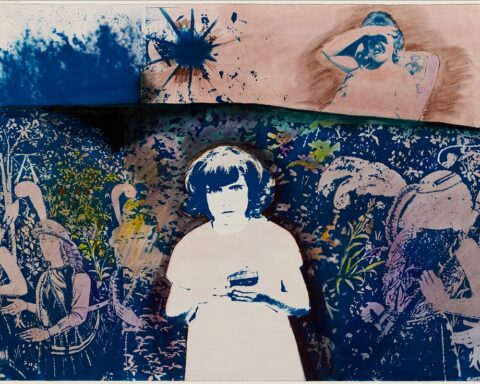The somewhat recent (2012) translation of Tiqqun’s Preliminary Materials for a Theory of the Young-Girl published by Semiotext(e) seems to be stimulating more conversation than the previous, less achieved, version. (Or at least the discussion is more above-ground and visible, likely due to Ariana Reines’ new translation as well as the wider sweep of Semiotext(e)’s distribution.) At the same time, it feels as though the conversation has barely begun—at least in a written form. It occurred to me to intervene when this piece by Moira Weigel and Mal Ahern appeared in The New Inquiry and was circulated with the customary rapidity by its proponents. Jaleh Mansoor responded to Weigel and Ahern in The Claudius App, in a vein of greater familiarity with Tiqqun, with a decidedly more marxist, perhaps communist, take on the questions they raised. It is a strong piece, and I will acknowledge it in what follows, along with Nina Power’s review in Radical Philosophy, which falls somewhere between the two in its usefulness.
Unlike Mansoor, I do not think it is in their oversights that Weigel and Ahern deserve a rejoinder. From an anarchist perspective, at least for those of us who read Tiqqun with tremendous interest (without entirely aligning ourselves with some more or less imagined Tiqqunist position), what is striking about them is just how symptomatic their response is—how much it tells without setting out to be much more than a dismissal, a nice excuse not to read, or not to think about what you didn’t really read. (The dismissal is, it’s true, followed by a weak exhortation. But the exhortation feels tacked on and is unlikely to be the reason their piece made the rounds.)
Weigel and Ahern’s reading of Tiqqun reveals to us their political presuppositions and shortcomings; it also pushes us to make our investment in certain positions consonant with Tiqqun’s more explicit. Anarchist conversations can be different if anarchists are willing to read everything more symptomatically—Weigel and Ahern and Tiqqun, yes, but also our own bodies, our own lives. What follows, then, is not an attempt to defend Tiqqun, much less to show the right way to read them, and more of an outline of what I would like to discuss—a sketch of a conversation some of us are learning to have.

To begin, a summary of what is at stake in Preliminary Materials for a Theory of the Young-Girl (PM). First, it was included in the first issue of the Tiqqun journal (1999) and then published separately by Mille et une Nuits (2001). Second, there is a clear conceptual linkage between the Theory of Bloom (published in the same issue, and also republished separately) and these Preliminary Materials. Bloom and Young-Girl are figures that appear in both texts (as well as here and there in Tiqqun’s other writings). To enter into this topic I’ll cite an appraisal of Tiqqun for antagonist projects from the recent collection Impasses:
In Theory of Bloom and Preliminary Materials for a Theory of the Young-Girl the critical work proceeds through figures. Bloom and Young-Girl are figures. They are not concepts … they are not demographic designators. They figure social phenomena that emerge in the twentieth century. These social phenomena have to do with forms of experience and subjectivity. When we talk about these in the U.S. way, we usually use the impoverished lexicon of identity politics.
Bloom and Young-Girl are part of what Tiqqun attempted in this journal—to borrow the quaint title of another piece in that issue, a “phenomenology of everyday life.” The aim is to see what is learned if we can describe some aspects of what manifests (what is made to appear) in societies like ours as Bloom, or as Young-Girl. That is what they mean when they write that Young-Girl is a “vision machine” constructed with the aim of “making the [social] battlefield manifest.” The theory of Bloom is developed in a mostly philosophical mode; the materials for the theory of the Young-Girl are gathered as fragments and presented as preliminaries, as if work remains to be done—or must be left incomplete out of some unnamed necessity. I will return to this below. Third, Young-Girl “is obviously not a gendered concept.” I repeat this because it merits repeating; it merits repeating because it has not been understood. Young-Girl, as a figure, allows us to map out and detect ways in which apparatuses of power produce, grasp and model the libidinal sphere in every sense, including those desires which so naturally or culturally seem to cleave into the two-and-then-some of sexual difference or the immediate manyness of genders. Put differently, though the figure is not intended to render a gender visible, it does model something about how gender has come to operate, insofar as gender is a crucial aspect of certain forms-of-life well integrated into societies like ours. Our good liberals and bad radicals enjoy saying that once a sexual or gender identity has been claimed or reclaimed by someone, it is, at least to some extent, free of power relations, of domination.
We counter that the model (explicit for the liberals, implicit for some radicals) for the value of this recognition is and always has been recognition by the state and the granting of legal and moral rights, of new forms of personhood; that, when it is not the legal model, it is the model of creative consumption, in which I believe I am discovering and expressing my true self as I navigate commodity-space; and concurrently that to expand the field of the normal (i.e. more rights, commodities tailored to what I think are my needs) will never amount to the kind of disruptive liberation we anarchists are after. I will return to this matter as well. Fourth, Bloom and Young-Girl are in a complicated relation of partial resonance with a third text published in Tiqqun 2, Sonogram of a Potential. This piece argues for an “ecstatic feminism” along lines I find congruent with my reading of the Bloom/Young-Girl dyad. I will make passing reference to Sonogram, though I do not mean to absorb it entirely into the theoretical space of the first two. Sonogram deserves its own discussion.
Weigel and Ahern make several symptomatic mistakes, or force several misreadings, concerning the least ambiguous aspects of Preliminary Materials for a Theory of the Young-Girl. The first is that, after an initial reference, they refer to the book as Theory of the Young-Girl. But the book is not The, or A, Theory of the Young-Girl. To treat a text that presents itself as preliminaries, outlines, notes, “trash theory”, as a finished product, is to ignore the first and clearest sign its author or authors could give as to how to approach it. This is telling considering the amount of space they devote to inveighing against a supposed irony in PM. It does not seem to me that PM communicates in any single tone, and, if it does, it would be something less ambivalent, such as “hate [of] the Spectacle.” Second mistake: they repeatedly state (and base part of their criticism on the claim) that Tiqqun wrote anonymously. But obviously, Tiqqun did not write anonymously; they wrote in and as Tiqqun. (Inability to distinguish between true anonymity and the use of pseudonyms, heteronyms, shared names such as Tiqqun, and multiple-use names (e.g. Luther Blissett) suggests, again, willful ignorance of the most obvious clues to interpretation.) Weigel and Ahern not only assimilate pseudonymous to anonymous writing, but more strikingly claim that here such practices “abet sexism” (note legalistic language). Mansoor responds appropriately on this point, arguing that pseudonymity and non-attribution of sources are in fact “an attack on the politics of textual propriety, the law of the copyright and of the father.” To which an anarchist might add that it is no surprise that our academics insist on identification of authors and citation of sources, and that we like to write, read, and discuss writing that refuses that insistence.
Weigel and Ahern get one thing quite right: Young-Girl is a figure. But they immediately botch their response by assimilating the figural to the real, as if Young-Girl were an idea, a concept, of actually existing young girls. They are like those who read Anti-Oedipus and get confused or offended when they “realize” that Deleuze and Guattari think psychotics should be shuffled into the place of the revolutionary subject. Or like those who read Nietzsche on the overman and think it is an argument for a genetic homo superior. (To someone who responds to PM by asking “Wait a minute, how has all the concreteness of the world taken refuge in my ass?”, one might well answer: “Wait a minute, why are you so comfortably identifying with a figure of hyperconsumption?”) What does it mean, then, that Weigel and Ahern fail to mind the dash and so miss what is figural about the figure? It means that they are able to read obtusely, “ontically”, as Nina Power puts it, whenever they need to make the claim that there is sexism or misogyny afoot in PM. The figure loses all of its diagnostic and critical power when it is grasped so crudely. It is not a theory of young girls we are talking about here, so why read it all as though it is about girls or women? It is a satire, in some sense, but not a satire of or about women or girls. It is a satire, or really a détournement with dark satirical effects, about gender and power, about how power works through gender (not just as sexism), about how we cling to gender and so to the power that works through gender. Ariana Reines wrote a fascinating set of notes on her work on PM. Her opinion:
I’d like to point out for the Anglophone reader that although the introduction asserts that the “Young-Girl is evidently not a gendered concept,” and that the term is applicable to young people, gays, and immigrants, French is a gendered language; and that, moreover, the genderedness of French is not the only way to account for the fact that this book, as it accumulates, does become—in some sections more than others—a book about women. With everything biological and constructed the term women signifies. A book about us. It contains passages rife with heterosexist ressentiment and, occasionally, whiffs of (what seemed to me to be) female intellectual rage against the more vapid and conformist members of our sex.
Reines puts her finger on the risk that PM runs, the risk, precisely, of a response like Weigel and Ahern’s: the accusation of garden-variety sexism, or, worse, extreme misogyny. No, it is not a side effect of the French language; it had to run this risk to make its point. No, the possible “female intellectual” did not have to out and name herself to keep the text safe from such accusations; it would have botched precisely what makes it work. (“Tiqqun claims it has lady members…” write Weigel and Ahern. Identify yourselves for proper textual/political evaluation.)
A remark about what makes it work: the reason, I would suggest, that the book is called Preliminary Materials is that so much of it is a collection of détourned texts. (Reines: “You should know that when a passage in the text sounds like a women’s magazine, that’s because it comes from a women’s magazine”). Now, the practice of détournement was conceived by the Situationists out of desperation, as they were seeking to abolish (among other things) art as a separated sphere of life. Their analysis was that any new creation (painting, film) would either prefigure, or simply work as raw material for, future commodification—if it did not already and inescapably bear the commodity form. As a response they attempted creations composed of repurposed images or fragments, whose contrast and conflict would not just represent but enact the negativity they felt towards the world. “This combination of parody and seriousness reflects the contradictions of an era in which we find ourselves confronted with both the urgent necessity and the near impossibility of initiating and carrying out a totally innovative collective action” (Situationist International #3, 1959). That is why Weigel and Ahern are wrong to simply describe this part (most) of PM as “Situationist-ish collage.” A collage suggests a fanciful assemblage of images that go well together, like a grade school assignment to make a poster showing what you want to be when you grow up, which assumes the images of your prospective adulthood are already there, waiting for you to shop among them and creatively recombine them. Détournement, however, is primarily negative—it concerns what cannot be said, shown, or felt except by glaring, sometimes violent contrast of text and image. It shows or says that what you want to show or say can’t be shown or said—its negativity arises from the feeling that life is impossible, that you have no way of being who or what you want to be.
So if and to whatever extent this book seems to be about girls or women, those girls or women are to be understood, I would say, along the lines of such a negativity. A future theory of the Young-Girl must pass through the negative reference to woman, girl, femininity, femaleness, all of that, because it follows the articulations and investments of power apparatuses in societies like ours. “The ‘youth’ and ‘femininity’ of the Young-Girl, in fact her youthitude and femininitude, are that through which the control of appearances extends to the discipline of bodies” (PM). Reines’ other main point: sustained work with the text produced in her a disturbing somatization. “I mean it gave me migraines, made me puke; I couldn’t sleep at night, regressed into totally out-of-character sexual behavior.” I imagine this is because it produces its effects precisely by rubbing the most disgusting aspects of our culture of consumption and recuperation in your face—not just citations of sexism or misogyny but terrible evidence of your participation in them, the way that you are capable of embodying the Young-Girl. (Reines’ nausea as a symptom of the unnamed necessity that leaves the materials in a preliminary form.) That is the darkness of its satirical effects, the negativity at work in its détournement.
That said, one could go too far in thinking that the reference to girls or women is all there is to the figure. Does this not also become a book about young people? Yes, because the apparatuses also invest the “youth” of the young, the citizens and consumers of the future, and the unlucky faces of every perverse desire of the now. Why do Weigel and Ahern not discuss the Young- component of Young-Girl? The short answer is that they have a target in mind: the Man-Child (note that, since man-child is hyphenated in ordinary use, this expression elides whether or not it is a figure, the Man-Child, or just man-children here and there who are under discussion—precisely their confusion about the figure of the Young-Girl). To make their point, they must treat PM as an off-balance, sexist critique that requires its balancing answer. Mansour detects the imaginary of equality at work here, and aptly intervenes:
[They] rely on a brand of feminism that takes symmetry for “fairness,” “equity” for “equality,” as though those were not already part of the metrics on which our contemporary social relations are founded. … We are supposed to find our place, as good citizens, in the immense system of equivalence posing as equality. […]
What we need is not a program, especially one of equality when equality in the face of the uneven history, of women under patriarchy and capitalism, has served to subjugate us ever more under false promises of wealth and legal juridical recognition.

Here we could also listen to Sonogram:
There is no equality possible between men and women, nor between men and men or women and women. The smooth surface of abstract arithmetic that forms the basis for the illusion of democracy constantly cracks under the obvious weight of irreducible ethical differences, under the arbitrary nature of elective affinities, under the suspicion that the circulation of power is a question of qualities that become incarnate, that power passes through bodies.
All of which is to say that, while Weigel and Ahern state that Tiqqun’s theory “is at the tail end of a radical tradition that has largely exhausted its usefulness,” we might notice that Tiqqun, in PM and especially Sonogram, set out from an exhaustion or impasse within feminism. The latter text strongly modifies the term with the adjective ecstatic in view of that impasse, while the former bluntly states: “The triumph of the Young-Girl originates in the failure of feminism.” According to Tiqqun, the more liberal forms of feminism were easily absorbed into social institutions whose basic coercive function was not altered, whereas the more autonomist and radical forms faced the same sociocultural counteroffensive as the entirety of the revolutionary Left (in this sense it is instructive to read Tiqqun’s two histories of the Italian 70s, This is Not a Program and Sonogram, side by side). I’ll briefly add that the attention-grabbing complement to Weigel and Ahern’s (as Mansoor rightly puts it) brand of feminism, the conceit of the Man-Child, is, as a joke, a dud; as criticism, it is limited to the narrow range of dudes in humanities graduate programs (who may well be neurotic and annoying, but aren’t especially the locus of power in a society like ours). What is worst about this preconceived target, and the sloppy reading of PM that Weigel and Ahern seem to need to pass through to get there, is that “his” irony allows them to misconstrue the practice of détournement in PM, which would otherwise have been an obstacle to their literal, ontic reading. And it is in this reading and its easily “actionable” object (the desideratum of “fairness” feminism, which always knows how to act once it finds the inequality to be equalized) that the mild popularity of Weigel and Ahern’s piece lies. Who cares what some obscure group had to say about capitalism and identity? It is complicated and difficult reading. It is easier to denounce man-children—who, let me be perfectly clear, I have no intention of defending.
But some of us anarchists would rather understand what the obscure group had to say about capitalism and processes of identification, even and especially if it troubles such moral and political commonplaces as fairness and equality; even and especially if it risks the thought of the failure of feminism so as to learn a different kind of lesson from its history. Back to the figural, then. The anonymous commentator in Impasses underlines that Bloom and Young-Girl have a mutual source. “For the Young-Girl as for all other Blooms, the craving for entertainment is rooted in anguish” (PM). But Blooms sometimes resist, and part of that resistance may be to write their own theory (said theory is still “of Bloom” in the other sense of the genitive); Young-Girls, by comparison, do not resist; they consume and express themselves, they seduce and are seduced, and so their theory never comes together.
For example, Bloom figures a crisis of sexuation, and Young-Girl figures the hypersexuality that is offered as the resolution to that crisis. Asexuals versus the pornosphere… It is in this sense that the figure of the Young-Girl is a diagnostic and critical tool. Its aim is not to represent or replicate a reality whose banalities (including the banality of everyday misogyny) some of us know all too well. Its aim is to allow us to understand the deployment of a particular kind of apparatus that invests the seemingly natural or culturally familiar categories of age and gender as counter-measures to the potential for social disavowal named Bloom. “Young-Girls constitute the most lethal commando THEY have ever maneuvered against heterogeneity, against every hint of desertion” (PM). We begin by cleaving society, along psycho-political lines, into those that resist, flee, or are at least capable of it, and those that do not. We note that the former can become part of the latter; and we note that the categories of age and gender are deployed selectively, qualitatively, as part of that operation.
Two provisional conclusions. First: to discuss the figure of Young-Girl as Weigel and Ahern do—not only ontically, but also apart from its relation to Bloom—is to miss precisely what an antagonist might find useful in it. The writer in Impasses observes that Bloom is a figure of anomie, of anyone’s disinvestment in society and social norms and bonds. This happens first as a seeming alienation, an implosion of the self’s reality:
… Bloom correspond[s] to a sense of being unreal without trusting the path offered back to the real. A first approach to the Young-Girl is to grasp that it is the figure of someone who abandons that sense of unreality in favor of what THEY offer as the path back to the real. Overall this is to be understood as an effect of power, a re-binding to the social real.
This is the Young-Girl as “offensive neutralization apparatus,” according to PM. It is aimed not at everyone, but specifically at Blooms, at what is Bloom in anyone and everyone. “If Bloom’s desire reveals no ultimate truths about oppression or freedom, it does on the other hand permit or prohibit desubjectivation; it increases or diminishes collective potential” (Sonogram). If Bloom is the refusal, sometimes the impossibility of work, look in what company the Young-Girl appears, according to This is Not a Program:
… work also has a more directly militaristic function, which is to subsidize a whole series of forms-of-life-managers, security guards, cops, professors, hipsters, Young-Girls, etc.—all of which are, to say the least, anti-ecstatic if not anti-insurrectional.
The anon in Impasses comments:
With the figure of Young-Girl we name the two principal contemporary forms of reintegration: identity and consumption as lifestyle. In their closely connected functioning, as identification with the Spectacle, the fundamental ambiguity of Bloom is betrayed, and the plans for exit are botched. The Young-Girl, Tiqqun say, is a model citizen; here citizenship is redefined as an explicit response to the threat of Bloom’s indifference to society.
The apparatus produces the phenomena that are found and figured as Young-Girl. Both aspects, Young- and -Girl, are vectors of commodification and reintegration, working together to generate permanent instability. Gender is part of the operation, but not gender alone. Age may undermine gender, and gender may undermine age. By this I mean that Young-Girl indicates the spurious empowerment of (some) women and (some) youth in societies like ours (the Spectacle’s “praise of femininity” (PM)), and at the same time the way that no position or identity thusly empowered is ever safe or stable. The paths to reintegration may almost always be described as modes of consumption: for young people, to consume what will make them pass as belonging to a world to which they are not yet fully adjusted (making them either mock adults or participants in subcultural pseudo/practice worlds); for women, to consume what will show their proper integration into society (as either an “equal” to men or belonging to a recognizable and recognized political protest ideology or grouping). “Blending into a fatal and complacent intimacy with things has become the mass activity for fetish-compatible Blooms” (Sonogram). The most criminalized, the most persecuted, the most vulnerable in all these games of power are precisely those who do not or can not be reintegrated, because they do not or can not participate in the necessary kind of consumption. Though we may have to fake it for the sake of survival.
Second provisional conclusion: to clearly distinguish between a moralistic, rights-and-recognition based, pro-identification politics and our anti-political alternative would be to rearticulate what is on the lips of so many people, especially young people, these days: that it is not only for seeming to belong to the wrong group that one is put down, shut out, yelled at, chased, beaten, and murdered, but especially for not seeming to belong to any group at all. So say those who today call themselves genderqueer or gender-nonconforming or other phrases that denote not identities but gaps between identities. So say those who for one reason or another are considered less than citizens of the Nation and bad subjects of (normal or other than normal) Sexuality. So say those for whom life in public and in private is lived as an interminable series of sex tests, gender tests, pleasure tests, body tests. One position would ask those of us who feel this way to answer the test questions, to settle on an identity, a name, a social zone, a project of seeking recognition and rights, and to wait for the crumbs to be handed out. Our anti-politics asks what there is left to do to live however we can and however we like, pushing aside every attempt to commodify the way we wear our outsiderness…

The tension is clear. Bloom is the figure of those who escape from identification—their potential rebelliousness, fragility, insanity, dangerousness, and so on. Young-Girl is the figure of those recaptured by identification in a process that makes identification seem liberatory insofar as it appears as their own and not imposed on them. “Reappropriating difference, which meanwhile has become biopower’s primary management tool, is obviously a lost cause” (Sonogram). And if age and gender are at work in this apparatus then what is at stake for us is, indeed, the question of gender. It is also what is glossed over by Weigel and Ahern: the question of youth. Like Mansoor, we are stridently anticapitalist and thus we respond differently to Tiqqun’s critique of social life in societies like ours than Weigel and Ahern. Far from a project of seeking equality or rights, we are driven to observe that almost any affirmation of gender—as natural, as socially constructed, as culturally specific, etc.—may be absorbed by the Young-Girl operation. That does not mean that any given one is or has been; but we are brought to admit that we need ethical criteria where none are to be found. Which is why some of us have been trying to elaborate more clearly (which may simply mean: practically) what the abolition of gender means. And though no one is speaking about the abolition of age, there is also an implicit negativity in our conversations towards the very path of life as it is set out for us. People used to, perhaps still do, talk about the liberation of youth.
Some of that is relevant here; but really the issue is that the age category itself makes increasingly less sense to those who have no discernible path to a stable adulthood, and those for whom adulthood can only be envisioned as a “comfortable” slow-motion implosion, for all of us torn from any acquaintance with a biological progression in our own bodies that is not also an awareness of the movement, pulse, gestures of power.
None of this is to say that what are clearly marked as Preliminary Materials for a Theory that, almost fifteen years later, has yet to appear, are sacrosanct or sufficient for an understanding of this tension, this terrain, this power. But it is to say that those who set out to criticize Tiqqun’s text without acknowledging such matters, or chalking them up to the rhetorical hyperbole of radical theory, are assuming precisely the normalcies and normativities that anarchists of our Tiqqun-reading stripe are out to destroy. “Because the only honorable departure from a minority status is not the achievement of recognition by the dominating majority or a change in force relations, but the deconstruction of the whole mechanism of recognition itself and of the idea of victory” (Sonogram). “A communization of bodies is to be expected” (PM).









